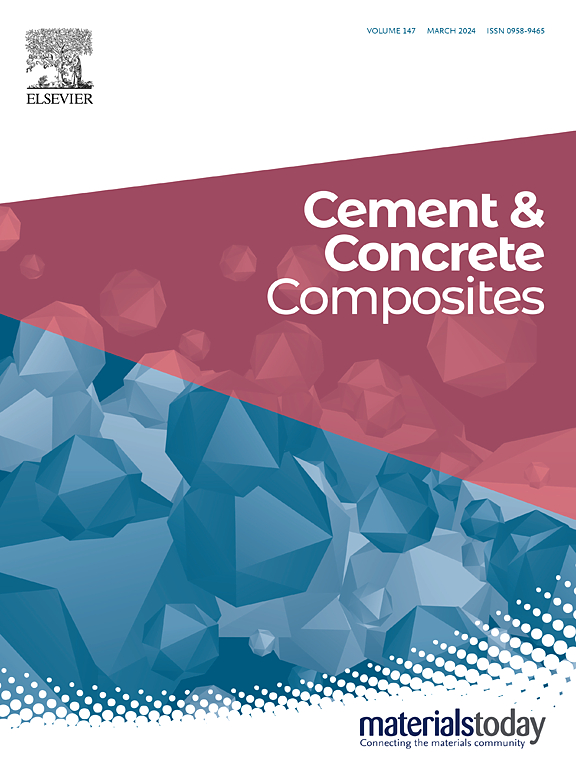烷基有机硅烷疏水水泥浆水化产物及杂化机理研究
IF 13.1
1区 工程技术
Q1 CONSTRUCTION & BUILDING TECHNOLOGY
引用次数: 0
摘要
水泥基材料由于其亲水性和富含毛细血管的结构,易受水渗透和水分诱导降解。有机硅烷整体疏水改性是提高其耐久性的一种有希望的解决方案,但最佳改性剂和潜在的杂化机制尚不清楚。本研究采用MIP、BSEM、XRD、TG、FTIR和NMR等技术,研究了不同烷基链长的有机硅烷(甲基- (C1TMS)、丁基- (C4TMS)、辛基- (C8TMS)和十二烷基-三甲氧基硅烷(C12TMS))的疏水水泥体的耐水性、孔隙结构、水化和杂化机理。其中,0.75%的C8TMS是最有效的疏水改性,水接触角达到144°,吸水率降低76.5%。C4TMS和C12TMS还通过将其烷基结构积聚成水合物和孔隙网络来增强耐水性。然而,与C8TMS相比,C12TMS过长的烷基链容易在水泥浆体中扭曲和聚集,抑制了水泥浆体的水解,降低了其疏水改性效果。相比之下,C1TMS提高了亲水性。这些有机硅烷通过将Ca2+吸附到偶联低聚物中或直接与C-S-H结合,参与形成杂化水化产物,使原料的水化率提高了6.1%。该研究为水泥体系中的有机-无机杂化以及在分子水平上设计多功能水泥基材料提供了新的见解。本文章由计算机程序翻译,如有差异,请以英文原文为准。
Hydration products and hybridisation mechanisms of hydrophobic cement pastes with alkyl-organosilanes
Cement-based materials are susceptible to water infiltration and moisture-induced degradation due to their hydrophilic nature and capillary-rich structure. Integral hydrophobic modification with organosilanes is a promising solution to improve their durability, while the optimal modifiers and underlying hybridisation mechanisms remain unclear. This study investigates the water resistance, pore structure, hydration and hybridisation mechanisms of hydrophobic cement pastes incorporating organosilanes with varying alkyl chain lengths, i.e., methyl- (C1TMS), butyl- (C4TMS), octyl- (C8TMS), and dodecyl-trimethoxysilane (C12TMS), using techniques including MIP, BSEM, XRD, TG, FTIR, and NMR. Among them, 0.75 % C8TMS yields the most effective hydrophobic modification, achieving a water contact angle of 144° and a 76.5 % reduction in water sorptivity. C4TMS and C12TMS also enhance water resistance by accumulating their alkyl structures into hydrates and pore networks. However, excessively long alkyl chains of C12TMS tend to twist and aggregate in the aqueous cement paste, inhibiting hydrolysis and reducing its hydrophobic modification effectiveness compared to C8TMS. In contrast, C1TMS improves hydrophilicity. These organosilanes participate in forming hybrid hydration products through adsorbing Ca2+ into coupled oligomers or directly bonding with C–S–H, improving hydration of raw materials by up to 6.1 %. This study offers new insights into organic-inorganic hybridisation in cement systems and designing multifunctional cement-based materials at the molecular level.
求助全文
通过发布文献求助,成功后即可免费获取论文全文。
去求助
来源期刊

Cement & concrete composites
工程技术-材料科学:复合
CiteScore
18.70
自引率
11.40%
发文量
459
审稿时长
65 days
期刊介绍:
Cement & concrete composites focuses on advancements in cement-concrete composite technology and the production, use, and performance of cement-based construction materials. It covers a wide range of materials, including fiber-reinforced composites, polymer composites, ferrocement, and those incorporating special aggregates or waste materials. Major themes include microstructure, material properties, testing, durability, mechanics, modeling, design, fabrication, and practical applications. The journal welcomes papers on structural behavior, field studies, repair and maintenance, serviceability, and sustainability. It aims to enhance understanding, provide a platform for unconventional materials, promote low-cost energy-saving materials, and bridge the gap between materials science, engineering, and construction. Special issues on emerging topics are also published to encourage collaboration between materials scientists, engineers, designers, and fabricators.
 求助内容:
求助内容: 应助结果提醒方式:
应助结果提醒方式:


